Sandwich Island Composites F-16 v1 vs. F-16 v2-video
I went to Sandwich Island Composites and had a chance to talk to the man himself, Mark Raaphorst. I saw the new S.I.C. F-16 version 2 (v2) SUP board side by side with the F-16 v1. I thought it would be good to compare the F-16 v1 with the new generation of F-16 v2 to find out the difference between the two versions. Watch the video and hear it straight from Mark R.

(click thumbnail to launch video)
First, both versions are hollow, molded and made of carbon. The F-16 SUP board is made for downwind and trade wind days. It comes to life on a 10 mph or faster and can hold up riders weighing 120 lbs. to 250 lbs. It really gets fun when the wind is 20 mph+.
The F16 v1 bottom has V in the middle along with dual concaves so it is very forgiving especially on side chops. It goes really fast when you use the Active Steering System (ASS) to catch a bump and ride it like a long board.
The Deck:
The difference between the two versions is that, the deck of the F-16 v1 is fairly dome shaped. While the F-16 v2, has a slightly scooped out deck. This gives you a better grip and feel of the board, although, both versions have an EVA pad for grip. I prefer the concave deck on the v2.
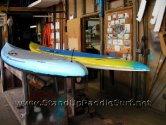 A dome shaped deck for F-16 v1 and scooped out deck for F-16 v2.
A dome shaped deck for F-16 v1 and scooped out deck for F-16 v2.
The Rocker:
The rockers are basically the same, except that Mark took off some tail kick on the F-16 v2 as opposed to version 1. The curve on the back was smoothened out whereas on version 1, the rocker is more accelerated. This is helpful on steeper swells.
The Tail:
The tail of the second version is thicker than F-16 v1. In the F-16 v2, S.I.C. moved the volume to the side, front, and back of the board, which keeps your feet dry when you are standing on the board because the water would just flow onto the sides rather than on the deck of the board.
The Rails:
Moving the volume outward and towards the nose and tail, the rails became boxier on the F-16 v2. There is a more pronounced V on the nose to shake off the water.
The Bottom:
The most noticeable difference on the two versions is the bottom of the board. F-16 v1 has a V in the middle with double concaves. Whereas version 2 has a single concave with 2 little side panels. This makes the v2 a bit more stable for balancing.
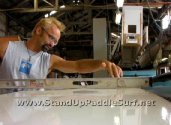 F-16 v1 bottom with a V and double concave
F-16 v1 bottom with a V and double concave
Changes in the bottom part of the nose are also obvious. The old version was made to follow the displacement style of lay down paddleboards. However, Mark realized that it doesn’t really help the board much when it hits the water. The changes on the F-16 v2 made the board ride over the peak of the bump in front, thus making connecting bumps easier. The fin and rudder system are pretty much the same. The F-16 v2’s fin was only made thinner to create less drag and lower aspect, but not too thin in order to avoid difficulty in steering, especially at lower speeds.
The F-16 v1 is also about an inch wider than the new version. While the F-16 v2 became narrower but the stability has improved because of the bottom contours.
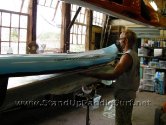 Mark Raaphorst with his new creation, F-16 v2
Mark Raaphorst with his new creation, F-16 v2
With all these changes made to the F-16 v2 SUP boars, you may think that the F-16 v1 is already considered outdated and non-functional. I was surprised to know that a lot of people still prefer the older version rather than the new one. Mark says that the new version will most likely be exported to other countries while the older one would remain available locally.
I personally prefer the additional stability of the F-16 v2 and the changes in the nose and bottom but everyone is different so it’s best to call Mark and talk to him directly www.paddlemaui.com. Tell him you saw it here on standuppaddlesurf.net and you’ll get V.I.P. treatment…well, maybe not but it should help.
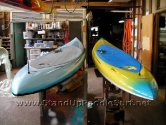
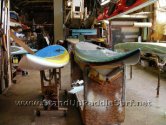
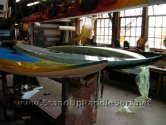



Great informative and provacative video, Ev. It’s always good to hear about the performance aspects of a board from the designer and Mark obviously put a lot of thought and r & d into his.
Another great video Evan. I was really interested to see the bottom shape detail and couldn’t help but notice some similarities to the Joe Blair 12′6. Very different nose design but both with the single concave, does the Joe Blair “V” at the tail like the F16? Would be real interested to hear your thoughts on the similarities. Aren’t we lucky to have guys like Joe and Mark that are so open and sharing with their designs and theories on board design.